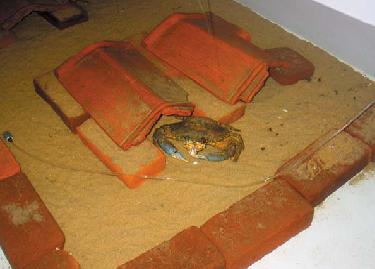|
Nursery Management
Larval rearing
Zoeae are stocked at a density of 50 individuals/l in circular concrete tanks (4
m diameter x 1 m height) and fed with the rotifer Brachionus rotundiformis
at a density of 10-15 rotifers/ml. The microalga Chlorella sp. is maintained
in the rearing tanks at 50,000 cells/ml as food for the rotifers. Brine shrimp Artemia
salina nauplii are also given at 0.5-3/ml to zoea 3 and larger larvae.
Artemia densities over 5/ml may not be economical to use in commercial-scale
hatcheries.
The zoeae are reared at a salinity of 32-34 ppt and water temperature of 26-30.5oC,
and a natural photoperiod of 11-13 hrs light and 11-13 hrs dark. The rearing water
is replaced at a daily rate of 30% starting on day 3 and increasing to 80% as larvae
grow bigger or when disease-causing luminescent bacteria are detected in the water
and larvae.

Crab maturation tank
(Source: RGCA)
Nursery
Megalopa are nursed in concrete tanks or in net cages set in brackishwater ponds.
To prevent or reduce cannibalism, the stocking density of 3-5 day old megalopa in
nursery tanks is reduced to 100-200/tonne of water. Black nets are placed at the
bottom as substrates and some are suspended in the water column. Food consists of
newly hatched and adult Artemia . As soon as the megalopa molt to crab
stage stage, they are fed minced trash fish, mussel, or small shrimp Acetes
twice daily ad libitum. About 30-50% of the volume of the rearing water (26-30
ppt) is replaced daily during the first 5 days and every two days thereafter.

A mud crab hatchery
Using several hatchery tanks to rear megalopa up to juveniles at low density is
not cost-effective because these are better used for rearing the zoea, which have
a faster turnover. Ponds provide a wider surface area for the dispersion of megalopa
provided that the ponds are predator-free and have substantial natural food. Nursery
net cages (mesh size 1 mm; bottom surface area 20 m2 are set in ponds
for the megalopa. Bamboo poles support the cages and the bottom of the net is buried
3-5 cm into the pond soil. A good growth of natural food is obtained about a week
after the application of organic fertilizer at one tonne/ha and inorganic fertilizers,
urea (45-0-0) at 75 kg/ha and ammonium phosphate 16-20-0) at the ratio of 1:2.
Megalopa to be transferred to net cages are packed in plastic bags at 200-300/l.
Megalopa are stocked at 30/m2 and fed adult Artemia on the first day
in net cages. Food is then changed to minced trash fish and mussel placed in feeding
trays. Water depth is maintained at 60-80 cm. About 30% of the water is replaced
3-4 times a month. Strategies to reduce cannibalism include size-grading, trimming
of claws, removal of chelipeds, and provision of sufficient shelters. However, chelipeds
are not removed from crabs larger than 2.5 cm in carapace width because growth may
be affected. Trimming the claws and removal of chelipeds are tedious and are practical
only for a small population of crabs. The survival from zoea 1 to 3-4 day old megalopa
is 3-7%. The survival from megalopa to juveniles (1-3 g body weight) after 30 days
in hatchery tanks or pond cages is 30-50%. A considerable number of crabs for growout
can be produced if the megalopa are nursed in net cages in ponds. Crabs that are
about 1 g and 2 cm in carapace width can be stocked directly in growout ponds. Hatchery-reared
crabs have been grown to marketable size in ponds since late 1999.

Crablets of mud crabs
(Source: RGCA)
Problems encountered in the crab hatchery
a) Egg loss in berried females due to fungal infection, epibiotic fouling, and unfertilized
eggs,
b) Luminescent bacteria, and
c) Cannibalism among megalopa.
The methods described above are being refined to improve the survival from megalopa
to crab stage so that the technology would become economically viable.
Top
|